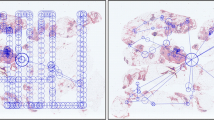Abstract
Digital screening mammograms (DM) take longer to interpret than film-screen screening mammograms (FSM). We evaluated what part of the process takes long in our reading environment. We selected cases from those for which timed readings had been performed as part of a previous study. Readers were timed as they performed various computer manipulations on groups of DM cases and as they moved the alternator and adjusted lighting and manual shutters for FSM cases. Subtracting manipulation time from the original interpretation times yielded estimated times to reach a decision. Manipulation times for DM ranged from a low of 11 s when four-view DM were simply opened and closed in a 4-on-1 hanging protocol before moving on to the next study to 113.8 s when each view of six-view DM were brought up 1-on-1, enlarged to 100% resolution, and panned through. Manipulation times for groups of FSM ranged from 8.3 to 12.1 s. Estimated decision-making times for DM ranged from 128.0 to 202.2 s, while estimated decision-making time for FSM ranged from 60.9 to 146.3 s. Computer manipulation time partially explains the discrepancy in interaction times between DM and FSM. Radiologists also appear to spend more time looking at DM than at FSM before making a decision.




Similar content being viewed by others
References
Berns EA, et al: Digital and screen-film mammography: comparison of image acquisition and interpretation times. AJR Am J Roentgenol 187:38–41, 2006
www.fda.gov/CDRH/MAMMOGRAPHY/scorecard-statistics.html. Accessed December 26, 2006, July 24, 2007, December 28, 2007, and October 2, 2008.
Pisano ED, et al: Diagnostic performance of digital versus film mammography for breast-cancer screening. N Engl J Med 353:1773–1783, 2005
Pisano ED, et al: Diagnostic accuracy of digital versus film mammography: exploratory analysis of selected population subgroups in DMIST. Radiology 246:376–383, 2008
Skaane P, Hofvind S, Skjennald A: Randomized trial of screen-film versus full-field digital mammography with soft-copy reading in population-based screening program: follow-up and final results of Oslo II study. Radiology 244:708–717, 2007
Del Turco MR, Mantellini P, Ciatto S, et al: Full-field digital versus screen-film mammography: comparative accuracy in concurrent screening cohorts. AJR 189:860–866, 2007
Haygood TM, Wang J, Atkinson EN, Lane D, Stephens TW, Patel P, Whitman GJ: Timed efficiency of digital and film-screen screening mammographic interpretation. AJR Am J Roentgenol 192:216–220, 2009
Lewin JM, et al: Clinical comparison of full-field digital mammography and screen-film mammography for detection of breast cancer. AJR Am J Roentgenol 179:671–677, 2002
Cole E, et al: Diagnostic accuracy of Fischer Senoscan Digital Mammography versus screen-film mammography in a diagnostic mammography population. Acad Radiol 11:879–886, 2004
Skaane P, Young K, Skjennald A: Population-based mammography screening: comparison of screen-film and full-field digital mammography with soft-copy reading—Oslo I study. Radiology 229:877–884, 2003
Skaane P, Skjennald A: Screen-film mammography versus full-field digital mammography with soft-copy reading: randomized trial in a population-based screening program—the Oslo II study. Radiology 232:197–204, 2004
Haygood TM, Whitman GJ, Atkinson EN, Nikolova RG, Sandoval SYC, Dempsey PJ: Results of a survey on digital screening mammography: prevalence, efficiency, and use of ancillary diagnostic aids. J Am Coll Radiol 5:585–592, 2008
Herrmann KA, et al: Zeitbedarf bei der befundung digitaler thoraxaufnahmen am monitor im verleich zum alternator. Roentgenpraxis 53:260–265, 2001
Hemminger BM: Soft copy display requirements for digital mammography. J Digit Imaging 16:292–305, 2003
Pisano E, et al: Interpretation of digital mammograms: comparison of speed and accuracy of soft-copy versus printed-film display. Radiology 223:483–488, 2002
Hendrick RE, et al: Accuracy of soft-copy digital mammography versus that of screen-film mammography according to digital manufacturer: ACRIN DMIST retrospective multireader study. Radiology 247:38–48, 2008
Acknowledgments
The authors thank Carolyn Spiceland for many rounds of word processing and both Raimund Polman and Thomas Paget for technical information.
Author information
Authors and Affiliations
Corresponding author
Rights and permissions
About this article
Cite this article
Haygood, T.M., Wang, J., Lane, D. et al. Why Does It Take Longer to Read Digital Than Film-Screen Screening Mammograms? A Partial Explanation. J Digit Imaging 23, 170–180 (2010). https://doi.org/10.1007/s10278-009-9177-9
Received:
Revised:
Accepted:
Published:
Issue Date:
DOI: https://doi.org/10.1007/s10278-009-9177-9




